carat - A unit of weight for gemstones, one carat is equal to one fifth of a gram or 200 milligrams. Also spelled karat.
Example:
![]()
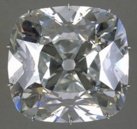
![]()
The Régent Diamond, 136 carats,
1 1/5 x 4/5 inches (3 x 2 cm), Louvre.
Also see jewelry.
Caravaggisti - Artists influenced by "Caravaggio", Michelangelo Merisi (Italian, Lombard, 1571/73-1610) — his dramatically contrasting dark-light effects; painters of "night pictures" in the "dark manner", a manner known as tenebrism (or by the equivalent Italian term tenebroso).
(pr. KAH-rə-vah-JEE-stee)
Examples of works by Caravaggio and his followers:

Caravaggio (Michelangelo Merisi) (Italian,
Lombard, 1571/73-1610), The Musicians, c. 1595, oil
on canvas, 36 1/4 x 46 5/8
inches (92.1 x 118.4 cm), Metropolitan Museum of Art, NY. (On
the Met's page, you can enlarge any detail.) See Baroque.
Caravaggio (Michelangelo Merisi) (Italian, 1571/73-1610), The Crucifixion of St. Andrew, 1607, oil on canvas, 202.5 x 152.7 cm, Cleveland Museum of Art.
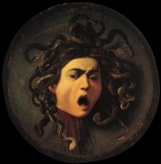
Caravaggio, Medusa, oil
on a circular convex
leather shield, diameter
55.5 cm, Uffizi Gallery, Florence. See mythology and snake.
Gerrit van Honthorst (Dutch, 1590-1656). Also see Dutch art.
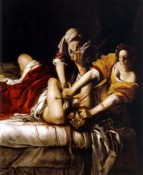
Artemisia Gentileschi (Italian, 1593-1651/53),
Judith
Beheading Holofernes, 1620, oil
on canvas, 78 3/8 x 64 inches
(199 x 162.5 cm)
Uffizi, Florence. See Baroque
and feminism and feminist art.
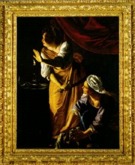
Artemisia Gentileschi (Italian, 1593-1651/53),
Judith and Her Maidservant with the Head of Holofernes,
c. 1625, oil on canvas,
1.8 x 1.4 m (72 1/2 x 55 3/4 inches, Detroit Institute of Art,
MI. See frame.

Georges De La Tour (French, 1593-1652), Magdalen with the Smoking Flame, c. 1640,
oil on canvas,
46 x 36 1/8 inches (116.8 x 91.8 cm), Los Angeles County Museum
of Art.
Valentin de Boulogne (French, 1594-1632), Concert, c. 1628-1630(?), oil on canvas, 1.75 x. 2.16 m, Louvre.

Diego Velázquez de Silva (Spanish,
1599-1660), The Luncheon (Three Men at a Table),
c. 1617/18, oil on canvas,
43 x 40 inches (108.5 x 102 cm), Hermitage Museum, St. Petersburg,
Russia.

Matthias Stom (aka Stomer) (Dutch, c. 1600
- c. 1652), Christ Before the High Priest, c. 1633,
oil on canvas,
Milwaukee Art Museum, WI.
![]()

![]()
Follower of Caravaggio, anamorphic
Saint
Jerome Praying, 1635, oil
on canvas.
Also see Baroque and nocturne.
carbide disk - An abrasive disk attachment for a power tool, a grinder perhaps.
carbon - A common non-metallic element that occurs in many inorganic and in all organic compounds, exists freely as graphite and diamond, and as a constituent of coal, limestone, and petroleum, and is capable of chemical self-bonding to form an enormous number of chemically biologically, and commercially important molecules. It is an important ingredient in steel and other alloys. Its elemental symbol is C; atomic weight 12.01115. The specific gravity of amorphous carbon is 1.8 to 2.1, of diamond 3.15 to 3.53, and of graphite 1.9 to 2.3. Also, may refer to a sheet of carbon paper, or an image produced by marks made to carbon paper.
carbon dioxide - A colorless, odorless, tasteless, non-explosive
and inert gas, CO2, formed
during respiration, combustion, and organic decomposition and
used in food refrigeration, carbonated beverages, inert atmospheres,
fire extinguishers, and aerosols. Tank sizes available are 20
and 50 pounds. Also
called carbon dioxide, carbonic acid, and, in aqueous solution
it's called carbonic acid gas. Solid carbon dioxide, or dry ice,
is a refrigerant. Toxic if
inhaled in large amounts.
Also see acetylene, argon, helium, hydrogen, nitrogen, and oxygen.
carbon paper - A paper that is coated on its underside with a dark pigment, and used to transfer writing and drawing to other surfaces. When marks are made with sufficient pressure upon its upper side, their likeness is transferred to the surface placed below the carbon paper with the pigments from its underside.
Also see copy, reproduce, rouge paper, tracing, and transfer paper.
carbon tetrachloride - An extremely toxic
solvent, possibly causing liver cancer
and severe liver damage, even
from small exposures. Exposure to
carbon tetrachloride can be fatal by skin absorption or inhalation.
Carborundum - Another name for silicon carbide, this is a hard crystalline substance used as an abrasive and in refractory compounds.
Also see corundum, emery, and rouge.
card or cardboard - A stiff paper which may be of any of many thicknesses, typically made of pressed paper pulp or adhered sheets of paper. Special types include bristol board, corrugated cardboard, foam core or foam board, illustration board, matboard, and oaktag. Sometimes cards are made from plastics. Cardboard has many uses. For example, it is employed as a material in making two-dimensional and three-dimensional work, and as a surface on which to mount other work. Card may also refer to a greeting card, postcard, business card, playing card, trading card, credit card, etc. In the fiber arts, to card is to comb out fibers with a wire brush (also called a card).
Examples of art using cardboard:

Naum Gabo (worked in Germany, England, and
USA, born Russia, 1890-1977), Model for 'Constructed Torso', 1917,
reassembled 1981, cardboard, 39.5
x 29.0 x 16.0 cm, Tate Gallery, London. See Constructivism,
torso, and model.

Robert Filliou (French, 1926-1987), Musique télépathique n° 5 (Telepathic
Music #5), 1976-1978, installation
of metal and cardboard,
Georges Pompidou Center, Paris. See Fluxus.
Also see carding, card stock, and package.
cardboard relief - A collage made up of pieces of cardboard. Cardboard reliefs can be used in relief block printing.
carding - Combing out fibers with a wire brush, usually in preparing fibers for spinning. Also, combining fibers between two such brushes for the same purpose.
cardo - The north-south road in Etruscan and Roman towns, intersecting the decumanus at right angles.
Also see Etruscan art and Roman art.
card stock - Card in the form it is received from a manufacturer, or a stored supply of card.
Also see paper.
career - See art careers.
carnival, carnivalesque - Carnival is an occasion or season of public celebration, often with parades, costumes, music, and dancing; an instance of merrymaking, feasting, or masquerading in riotous excess. As such, carnival is celebrated in Roman Catholic regions during the three-day period before Lent — 40 days of fasting and sacrifice. Examples include Mardi Gras (French for "Fat Tuesday", meaning Shrove Tuesday) in New Orleans, LA, and carnivals in cities across Europe and Latin America. Many historians assert that carnival has roots in the ancient Roman festivals Saturnalia (Saturn's festival) and Lupercalia (honoring Faunus, god of fertility and forests), characterized by Bacchanalian revels of unbridled freedom. Thus carnival's temporary subversions of civil order reveal links between Christians' annual remembrance of Christ's redemption from sin to pagans' seasonal celebration of winter's end and spring's beginning.
A carnival can also be a traveling enterprise offering amusements, or an organized program of entertainment or exhibition comparable to a circus.
"Carnival" was derived from 16th century Italian carnevale, which came from Latin carn "flesh" and carnelevamen "cease eating meat" during Lent.
Carnivalesque is the tendency toward abandoning self-restraint. Although the West is most aware of its expression in the period before Lent, such behaviors are seen in nearly every culture. America's celebration of Halloween and Mexico's of Dia de los Muertos are characterized by the carnivalesque, for instance.
Quote:
Carolingian art - French and German art from the end of the eighth to the early tenth century. Stimulated by Charlemagne's forming the first Holy Roman Empire, and his revival of scholarship both at his court and in the monasteries, artisans created beautiful illuminated manuscripts and works in gold, silver, and gems, among other materials. Carolingian artists laid a solid foundation for the Middle Ages.
Examples:

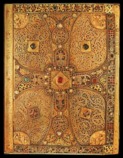
Carolingian France, Lindau Gospel,
front
cover of the book, and the
back cover, c. 800, embossed
gold, gems,
enamel. See bookbinding.
Carolingian France, Equestrian Statuette of Charlemagne,
ninth century, bronze with traces
of gilt, 9 1/4 inches high (23.5 cm),
Louvre. See equestrian statue.

Carolingian, 1st third of 9th century, St.
Stephen's Purse, clasp: 15th centurs; reverse side: about
1827, gilt wood,
precious gemstones, pearls,
glass; reverse
side: silver
gilt, 32 cm high, Kunsthistoriches,
Museum, Vienna.
France, Paris, before 1380, Charles V Sceptre, gold, pearls, gemstones, glass, height 0.60 m, Louvre. This sceptre was produced long after Charlemagne's death, but it is of interest here because a statuette of Charlemagne sits on top of it.
Related resource:
Also see Ada school and Middle Ages.
carta pesta - Italian for papier-mâché.
carte de visite or carte-de-visite - Separate photographs made on a single negative and mounted on a card the size of a standard calling card. In the nineteenth century, this was an inexpensive means of creating mass-produced prints.
(pr. KART də-vee-ZEET)
Examples:
André-Adolphe-Eugene Disderi (French, 1819-1889), Martha Muraviena in the Ballet "Nemea", 1864, albumen print, uncut carte de visite sheet, 19.7 x 24.5 cm. (irregular), George Eastman House, Rochester, NY. Disderi patented carte-de-viste portraiture in 1854. Cartes de visite portraits soon became more popular than daguerreotype portraits. They were so popular that people began collecting cartes de visite portraits of famous people.
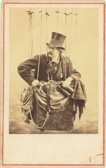
Félix Nadar [Gaspard-Félix Tournachon] (French, 1820-1910), Self-Portrait as an Aeronaut, c. 1863, albumen print carte-de-visite,
3 1/16 x 2 3/16 inches, J. Paul Getty Museum, Malibu, CA.
Unidentified Photographer (American, active 1860s), Civil War Soldier with Sword, c. 1862, albumen print carte-de-visite, 9.5 x 5.4 cm, George Eastman House, Rochester, NY.
The plural form is cartes de visite. French in origin.
cartoccio - Italian for cartouche.
cartography and cartographer - Cartography is the making of maps, and a cartographer is a person who makes maps. In ancient times, maps were often decorated with fanciful beasts and monsters instead of accurate details about places. French mapmakers of the 1700s and 1800s encouraged the use of more scientific methods in the art they called "cartographie." The French word "cartographie" was created from "carte," meaning "card" or "map," and "-graphie," meaning "writing." For examples of cartographic images, see map.
(pr. kahr-TAHG-rə-fee and kar-TAHG-rə-fər)
Also see interdisciplinary and science and art.
cartoonist - An artist who draws cartoons or comic strips for newspapers, magazines, etc. A cartoonist link:
Also see caricature and Rube Goldberg.
cartouche - An ornamental figure which serves as a frame for an inscription or a decoration within a space which usually has a scroll-like, or an oval or lozenge shape, this figure having a form which is irregular or fantastic. A cartouche may be painted, sculpted, engraved, etc. Often specifies oblong figures enclosing Egyptian hieroglyphic names of gods and royalty. Also much used in the sixteenth and seventeenth century Europe to decorate walls and the title pages of books. Another sort of cartouche, a plaque attached to a work of art, its frame or base, and inscribed with the title, artist's name, etc., is often referred to by its Italian name, cartoccio.
(pr. kar-TOOSH)
Examples:


Perhaps the most famous monogram of any artist
is that of Albrecht Dürer (German, 1471-1528). He used it
frequently as his signature on
his works. The detail on the left is from the lower-left corner
of the engraving
Knight,
Death, and the Devil, Dürer placed his monogram
and the date within a cartouche. See Northern Renaissance.
Also see niche.
cartridge paper - A British term for almost any inexpensive paper. These may be of almost any weight or finish. Such paper is unlikely to be of archival quality, because it is probably not acid-free. Cartridge paper is typically used for sketches, much as newsprint is.
caruncle - Anatomical name for the pink spot at the inner corner of each of the eyes.
(pr. Kə-RUNK-əl) Also see iris, lens, pupil, retina, and sclera.
carving - The technique
of cutting and abrading the
surface of a block
of material to shape
it into a particular form. Among the materials
appropriate for carving in schools include clay,
chalk, plaster,
soft salt blocks, artificial
sandstone, bar soap, and wax.
particular form. Among the materials
appropriate for carving in schools include clay,
chalk, plaster,
soft salt blocks, artificial
sandstone, bar soap, and wax.
Also see subtractive, assemblage, construction, dent, detritus, erasure, fragment, hollow carving, kerf, mark, misericord, modeling, sculpture, solvent, statue, stress, and the names of materials typically carved, such as alabaster, limestone, marble, and wood.
caryatid - A carved female figure used as a column. Dressed in long robes, she supports an architectural element on her head. Her male counterpart is an atlant, atlantid, or atlas. The word caryatid is Greek, and originally referred to maidens of Caryae in Laconia who performed ritual dances at the festival of Artemis.
(pr. KAR-ee-A-təd)
Examples:

Greece, Caryatid Mirror, c. 470 BCE,
bronze, height 42 cm, diameter
mirror disc 17.5 cm, George Ortiz
collection. This is allegedly from Dodona, North-East Peloponnese,
Sicyon? See caryatid and Greek art.

Two caryatids, among the six on the Porch
of the Maidens on the Erechtheion, on the acropolis
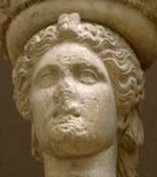 of Athens.
of Athens.
The photographs to the left and right were made before the caryatids
were removed from the Erechtheion in the early 1990s, because
they were being damaged by air pollution. Now safely installed
in an Athenian museum,
marble casts
have replaced them on the porch.

Auguste Rodin (French, 1840-1917), The Fallen Caryatid Carrying her Stone,
c. 1880-1, bronze,
42.5 x 279 x 33.0 cm, Tate Gallery, London.

Buli Master (Democratic Republic of the Congo,
Luba, active c. 1850-1900), Caryatid Stool, 19th century, wood,
metal studs, height 24 inches
(61 cm), Metropolitan Museum of Art, NY. See African art.

Olowe of Ise (Nigeria, Ekiti region, Yoruba,
c. 1873-1938), Caryatid Post: Equestrian, before 1938,
wood, pigment,
height 71 inches (180.3 cm),
Metropolitan Museum of Art, NY. See African art.

Amedeo Modigliani (Italian, 1884-1920), Caryatid, c. 1913-4, drawing on paper,
54.9 x 44.8 cm, Tate Gallery, London. This and the following
rhythmical designs are among at least
74 drawings of caryatids Modigliani made. See Expressionism.

Amedeo Modigliani, Rose Caryatid (Audace), c. 1914, gouache and chalk on paper,
60 x 45.5 cm, Norton Gallery of Art, West Palm Beach, FL, USA.


Amedeo Modigliani, Caryatid, 1914, limestone,
36 1/4 x 16 3/8 x 16 7/8 inches (92.1 x 41.6 x 42.8 cm), Museum of Modern Arts, New York, NY, USA.
Although Modigliani intended to carve numerous caryatids in stone,
only this one is known. (Another photo of it.) Jedlicka has written that Paul Guillaume
told him Modigliani planned to build "a temple not in honor
of God, but of humanity, which was to be surrounded by hundreds
of caryatids, 'columns of tenderness.' "
![]()
Paul Manship (American, 1886-1966), Caryatid, no date, pencil
on paper, 3 x 1 1/2 inches (7.5 x
2.7 cm), Smithsonian Museum of American Art, Washington, DC.
Also see Greek art and statue.
casein paint - A paint much like opaque watercolor in which casein — a milk glue — is its binder. Casein is a white, tasteless, odorless protein precipitated from milk by rennin. Casein is the basis of cheese, and is used to make plastics, adhesives, and foods, as well as paint. Casein paint can be used on paper or board for light impasto, for underpainting, wall decoration, etc. Casein paint is too inflexible for use on canvas.
It dries quickly with a waterproof surface, and may be varnished.
(pr. kay-SEEN)
Also see American Watercolor Society (AWS).
casein engraving - A technique in which a piece of Masonite board is built up to about 1/16 inch thickness in multiple layers of casein. This is then used as a plate for engraving. The engraved surface should be sealed before inking.
cast - To form (molten metal, or liquid plaster or plastic, for example) into a three-dimensional shape by pouring into a mold; or something formed by this means. Also, an impression formed in a mold or matrix.
Also see hollow casting, lost-wax casting, posthumous, and statue.
castrum - A Roman military encampment.
Also see Roman art.
catacombs - Underground tunnels in which the early Christians in Rome and other communities buried their dead. Some catacombs also contained chapels and meeting rooms. The painted decorations found in the catacombs are the earliest known forms of Christian art.
(pr. KA-tə-KOHMZ)
Also see cubiculum and sarcophagus.
catalog or catalogue - A list which is an inventory of works in a gallery, museum, or other collection. It describes the works, and may contain articles discussing their history, and classifying them in other ways. It may be in the form of a file of cards (or an electronic equivalent), one card for each object, or in the form of a publication (usually a pamphlet or book), whether for a special exhibition or for all or part of a permanent collection.
Also see accession, catalogue raisonné, curator, deaccession, docent, donation, and gallery.
catalogue number - A term used in a variety of ways in museums and other collecting entities. In some museums a catalogue number is assigned to a work based on its class, so that the number's purpose is description. In some museums the accession number is called a catalogue number, in which case its purpose is identification. A catalogue number may also be the number assigned to an object in a printed publication or catalogue of a special exhibition or collection.
catalogue raisonné - A monograph purporting to contain a complete list of an artist's works, or all of an artist's works produced in certain media or during a limited period of time. It typically includesdescriptions, photographs, notes on provenance, collections, samples of signatures, a thorough chronology of notable events in the artist's life, and a bibliography. When one is passionate about an artist's work, one relishes seeing the complete works, along with authoritative writings about the artist and the works. This makes the study of the artist's catalogue raisonné of utmost importance. Although "catalogue raisonné" was originally a French term, English speakers have used it for a long time.
(pr. RAY-zə-NAY)
Examples:

Maria Jawlensky, Lucia Pieroni-Jawlensky, and Angelica Jawlensky, authors, Alexej von Jawlensky - Catalogue Raisonné of the Oil Paintings Volume One 1890-1914, 1991. This is the jacket of the book, 522 pages, 246 color and 446 halftone illustrations, cloth covered binding, 292 x 265 mm, Philip Wilson Publishers, Limited, London. It is one in a set of three volumes, each sells new for $275.00, £175.00, or €283.50. It is not unusual for a catalogue raisonné to be finely printed in a limited number, and quite expensive; and when one goes out of print, naturally it becomes even more dear. See Der Blaue Reiter, Expressionism, Fauvism, and Russian art.

Ellen G. Landau, author, with the assistance of Jeffrey D. Grove, Lee Krasner: A Catalogue Raisonné, 1995,
Harry N. Abrams, Inc., publisher. See Abstract Expressionism and feminism and feminist art.
catalyst - A substance which provokes a chemical reaction in other materials without itself changing. For example, an egg will emulsify water and oil by acting as a catalyst. In resin sculpture, a catalyst must be added in order to cause the resin to harden. An accelerator, usually already added to the resin, reacts with the catalyst and heat is generated which sets off the hardening process.
(pr. KAT-ə-list)
Also see adhesive and emulsion.
cathedral - The principal church of a diocese, which contains the cathedra, or bishop's chair.
Another resource:
Also see aisle, apse, architecture, basilica, chapel, clerestory, crocket, cruciform, Gothic, hypostyle hall, Middle Ages, misericord, nave, square schematization, stained glass, trabeation, triforium, and vault.
caustic
- Corrosive. Be careful to read all warning labels, and take all
precautions necessary with materials
noted as caustic.
Also see ASTM International (American Society for Testing and Materials), cleaning art, clean up, flammable, hazardous, poison, solvent, toxic, and volatile.
cave painting - See Stone
Age.
https://inform.quest/_art